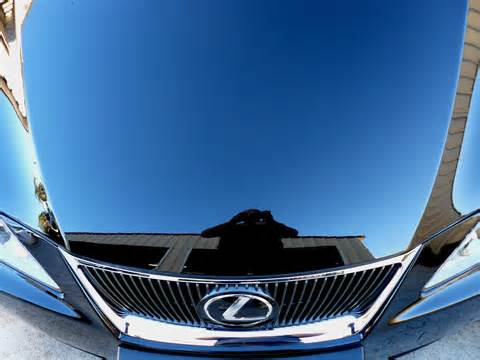Waxing is generally done with products containing a large amount of caranauba wax (a wax that is derived from the caranauba palm) or synthetic wax. Wax is applied to the exterior paint or clear-coat of the car and is then buffed using a soft rag or cloth. In contrast, polishing uses either an abrasive polish or a chemical polish that is rubbed onto the exterior of the vehicle.
Even some manufacturers confuse the terms polish and wax which really undermines their credibility. Putting wax over a bad paint finish will just seal in the imperfections and will not enhance the appearance of the paint so waxing is a final finishing job only.
Polishing is only something you should do when the paint finish has become flat. Years of dirt grime and road film along with sunlight can degrade the finish on a car. Red cars seem to be much more susceptible to sunlight degradation that other colors and the paint turn a dull pink color (this is caused by oxidation).
Each time you polish the car you are removing a small layer of paint and if you do this too often you will go through to the undercoat and the only way of fixing that is to re-spray the car.
You need to determine if the paint defect is above or below the surface. After washing the car sweep your fingers over the paint and if it feels smooth any defects are below the surface and if it feels rough, pitted or slightly sticky it indicates above surface imperfections.
Below surface defects are dealt with by polishing and above surface defects like traffic film, tar, bug guts and the like are best treated with a clay bar. (Follow the instructions that come with the clay but it is a simply a case of wiping the warm clay over the paint with a supplied lubricant to trap the dirt particles. It is a time consuming process but this makes a big difference to the finish of your paint especially on lighter color cars which seem to show every slight imperfection in the paint.
After a clay bar treatment look closely at the paint – if there are still imperfections these will be below surface and need to be polished out. Any stone chips and scratches should be touched up at this point before applying the wax because paint will not adhere very well to a waxed surface.
How to use car polish
To polish the car apply the cutting paste to a soft cloth and rub in a circular motion, use plenty of polish and make sure the cloth does not dry out. If you are removing a scratch or specific flaw include the surrounding area, aiming to fade in the freshly cut paint to the old paint and make sure that the freshly polish paint does not stand out – you may even need to do the whole panel if the paint is badly faded in order to match it in.
It is best done in stages because you only want to cut away the smallest amount of paint to remove the imperfections. Although an electric polisher will make the job a lot quicker, it is very easy to remove too much paint and allow the undercoat to show through so avoid using one unless you really have to. Wax can be applied with an electric polisher and a fantastic finish is possible in a very short time.
Many scratches from keys, scrapes in car parks and other damage can be almost completely removed with polishing as these photographs show.
A nasty scrape is rendered virtually invisible with a bit of polishing. So, before you take the car to a body shop for a re-spray quote have a go at polishing out the damage and see what the true extent of the damage is.
Many thanks to forum member Freddie for his photographs which demonstrate that if you know the difference between wax and polish you really can make a big difference to the finish of your car. Generally wax a car every 3-6 months and polish the car only when the paint becomes dull as outlined in the method above.
Our favorite wax is Collonite 476 – it lasts a long time and gives a good deep protection. We also recommend Meguiars NTX Tech wax and Autoglym super resin polish for older cars with slight imperfections in the paint and for cars with lots of imperfections the Bilt-Hamber Ultra Fine Paint Conditioner.

What’s the difference between car wax and polish and which one should I apply?
by
